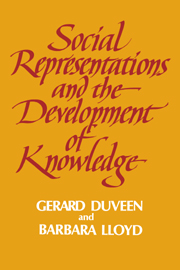Book contents
- Frontmatter
- Contents
- List of figures
- List of tables
- List of contributors
- Acknowledgements
- 1 Introduction
- 2 The underlife of the nursery school: young children's social representations of adult rules
- 3 A semiotic analysis of the development of social representations of gender
- 4 Children's representations of social relations
- 5 Social representations of childhood: an implicit theory of development
- 6 What is in an image? The structure of mothers' images of the child and their influence on conversational styles
- 7 The acquisition of reflexive social emotions: the transmission and reproduction of social control through joint action
- 8 From social cognition to social representations in the study of intelligence
- 9 Prototypes of the psychologist and professionalisation: diverging social representations of a developmental process
- 10 Social psychology and developmental psychology: extending the conversation
- Author index
- Subject index
3 - A semiotic analysis of the development of social representations of gender
Published online by Cambridge University Press: 08 March 2010
- Frontmatter
- Contents
- List of figures
- List of tables
- List of contributors
- Acknowledgements
- 1 Introduction
- 2 The underlife of the nursery school: young children's social representations of adult rules
- 3 A semiotic analysis of the development of social representations of gender
- 4 Children's representations of social relations
- 5 Social representations of childhood: an implicit theory of development
- 6 What is in an image? The structure of mothers' images of the child and their influence on conversational styles
- 7 The acquisition of reflexive social emotions: the transmission and reproduction of social control through joint action
- 8 From social cognition to social representations in the study of intelligence
- 9 Prototypes of the psychologist and professionalisation: diverging social representations of a developmental process
- 10 Social psychology and developmental psychology: extending the conversation
- Author index
- Subject index
Summary
In this chapter gender is analysed as a semiotic system in which particular values, ideas and practices are associated with the designations ‘female’ and ‘male’. These categories provide the framework for marking a range of material elements, personal dispositions and behavioural styles. These elements, dispositions and styles are in turn comprehended as signifiers of gender and provide the resources which individuals employ to express a social gender identity.
Sign systems function as a means of communication for social groups, and their operation is dependent on the intersubjectively shared representations of group members. In this sense sign systems can be seen as an expression of social representations. We have used the concept of social representations to explore social psychological aspects of gender (Lloyd, 1987; Lloyd and Duveen, 1989). In this chapter a detailed consideration of the nature of semiotic relations provides the framework for a discussion of developmental changes in the construction of social gender identities through a reexamination of material from studies of young children's gender knowledge.
Developmental semiotics
When someone describes a doll as a toy for girls, or a gun as a toy for boys, they are not describing characteristics which are physically inscribed in these toys, but the social markings of these objects. Mugny, De Paolis and Carugati have observed that social marking ‘connects relations of a cognitive order with those of a social order’ (1984, p. 137). This connection arises through the use of the same social representation to mark objects as well as to structure the cognitive processes required to comprehend the markings.
- Type
- Chapter
- Information
- Social Representations and the Development of Knowledge , pp. 27 - 46Publisher: Cambridge University PressPrint publication year: 1990
- 22
- Cited by



